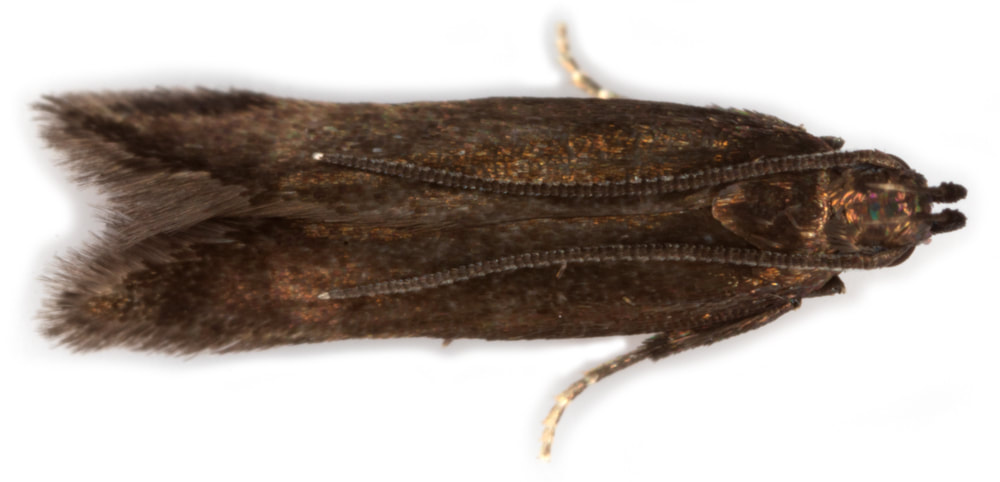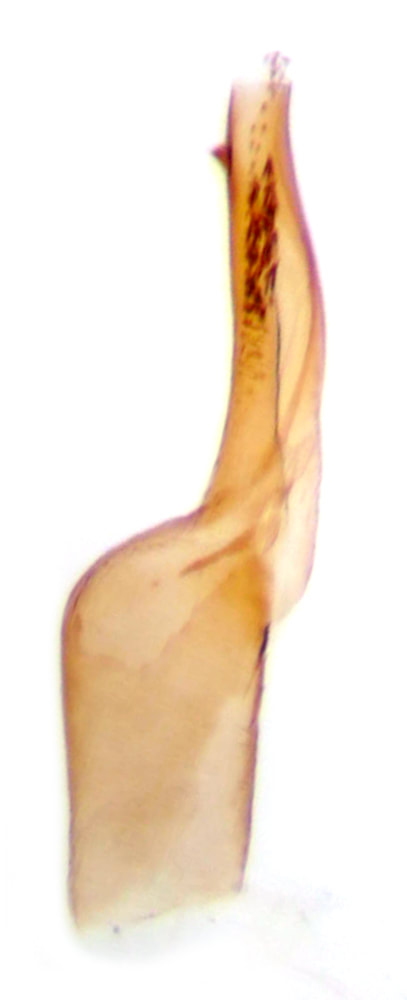35.066 Monochroa tenebrella (Burnished Sorrel Moth)
ws: 10-12mm; Jun-Jul; sheep's sorrel (Rumex acetosella); common throughout Britain
ID to genus from male genital key: Abdominal segment 8 forming complete ring around genitalia; uncus not divided into two lobes; valvae symmetrical; gnathos absent; tegumen with uncus shorter than valvae; uncus short and wide, hardly differentiated from tegumen; valva not expanded towards apex; aedeagus stout, tapering; sacculus not circular, often curved > Monochroa
ID to species: Forewing without longitudinal blackish streaks or stigmata; head not whitish; forewing glossy dark purplish fuscous > M.tenebrella
Discussion: Not sure how easy it would be to make the distinction with certainty between 'glossy dark purplish fuscous' of tenebrella and 'dark fuscous, irrorate grey' of conspersella; but conspersella is confined to fens of east England and so is unlikely to be found on a farm in Wales.
Female tenebrella has the apical 1/3 of antenna white. The male antenna is described in MBGBI4ii as black, but in all the images I have seen labelled as this species the apical segment is white - as shown by specmen §1 - not sure if this represents a distinctive feature of this species.
Male genitalia are distinctive - no other species of Monochroa has the apex of the valva produced into an point smoothly curved with both costal and lateral edges of the valva; or a keeled thorn near the apex of the aedeagus.
Eulamprotes unicolorella appears externally similar except that S2 and S3 of the labial palp are of equal length and the female antenna is all dark fuscous.
ID to species: Forewing without longitudinal blackish streaks or stigmata; head not whitish; forewing glossy dark purplish fuscous > M.tenebrella
Discussion: Not sure how easy it would be to make the distinction with certainty between 'glossy dark purplish fuscous' of tenebrella and 'dark fuscous, irrorate grey' of conspersella; but conspersella is confined to fens of east England and so is unlikely to be found on a farm in Wales.
Female tenebrella has the apical 1/3 of antenna white. The male antenna is described in MBGBI4ii as black, but in all the images I have seen labelled as this species the apical segment is white - as shown by specmen §1 - not sure if this represents a distinctive feature of this species.
Male genitalia are distinctive - no other species of Monochroa has the apex of the valva produced into an point smoothly curved with both costal and lateral edges of the valva; or a keeled thorn near the apex of the aedeagus.
Eulamprotes unicolorella appears externally similar except that S2 and S3 of the labial palp are of equal length and the female antenna is all dark fuscous.
§1 Cyffdy Farm, Gwynedd; 25/06/2010; male; fw 5.0mm
§2 Folkestone Warren, Kent; 04/07/2013; male; fw 5.0mm
§3 Lewes Down, East Sussex; 13/06/2020; male; fw 5.2mm; netted by day
§4 Lewes Down, East Sussex; 13/06/2020; male; fw 5.0mm; netted by day
§5 Applecross, Ross & Cromarty; 20/06/2022; male; fw 5.3mm; netted by day
All images © Chris Lewis
§2 Folkestone Warren, Kent; 04/07/2013; male; fw 5.0mm
§3 Lewes Down, East Sussex; 13/06/2020; male; fw 5.2mm; netted by day
§4 Lewes Down, East Sussex; 13/06/2020; male; fw 5.0mm; netted by day
§5 Applecross, Ross & Cromarty; 20/06/2022; male; fw 5.3mm; netted by day
All images © Chris Lewis
Page published November 2011 (§1) | §2 added 22/04/2014 | §3&4 added 21/01/2021 | §5 added 09/10/2022



















